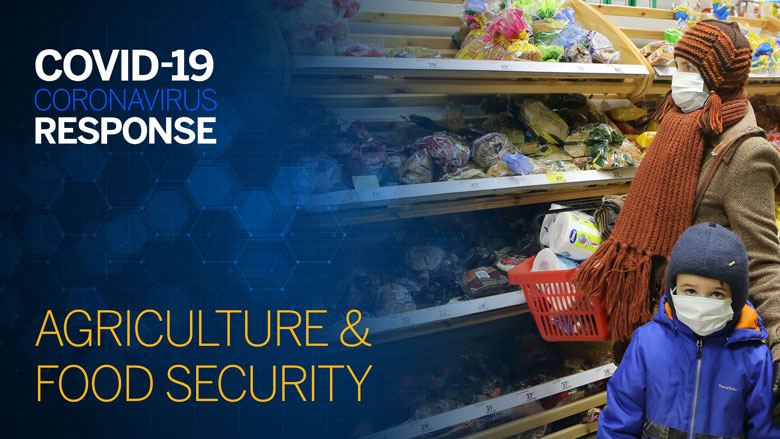
CHALLENGES
Consumer expenditure on food is declining along with income.
During the 2008–09 food price crisis, consumers in Russia reduced their consumption of more expensive food, such as dairy products and fish, and instead increased their intake of cheaper meal ingredients as real income declined. For example, pasta saw a 5 percent volume growth in 2009 over the previous year. Similar patterns were observed during the Russian financial crisis in 2014–15. If consumer behavior follows this same pattern during the current pandemic, the agriculture sector could be negatively impacted and the past decade’s gains toward the production of higher value and more profitable agricultural products could be reversed.
Labor shortages may affect value-added food production and amplify the negative impacts of changing consumer behavior.
As migrant workers have largely returned to their home countries, there may be a significant labor shortage in Russia, especially in labor-intensive, high-value agricultural production and processing. With travel restrictions in place, migrant workers cannot easily return to Russia, hence the shortage of workers could increase over time. Various estimates suggest that approximately 23,000 workers are needed in Russia for seasonal agricultural work.
Transport restrictions may affect agricultural supplies and inputs.
As in other countries, movement restrictions between cities may affect agricultural supplies. For instance, milk trucks may find it difficult to collect milk from their main suppliers. Suppliers of agricultural inputs may also face logistical problems. One critical bottleneck is that livestock production depends on the supply of imported inputs (pre-mixed feed, daily chicks, etc.), which will likely be affected by the disruptions. The COVID-19 pandemic may also delay the supply of crop protection materials, seeds, fertilizers, and spare parts for agricultural machinery. The shortage of these kinds of critical inputs could be exacerbated should the Russian ruble depreciate.
Agricultural enterprises could face bankruptcy.
Agricultural enterprises often operate on thin margins, and a reduction in sales will significantly affect their profitability. If the crisis endures, there is a risk that many enterprises will go out of business—a common outcome in the Russian agricultural sector in the aftermath of the previous crises.
Supermarkets could face temporary supply shortages.
As demand for agricultural products shifts from restaurants, schools, and other institutions to supermarkets and home consumption, supply chain problems can arise. For example, goods sold in supermarkets are generally packaged in smaller quantities and barcoded for supermarket checkouts. Consequently, consumers may face sporadic shortages even as farmers are unable to market their crops. Although stocks of goods exist, supply chains may not be flexible enough to shift supplies to the food retail sector.
The processing sector could be affected by a breakout of COVID-19 infections among the work force, creating additional supply-chain bottlenecks.
In the United States, positive tests for COVID-19 among workers at meat processing plants has disrupted regional markets for beef and pork. A similar chain of events could occur in Russia.
WHAT RUSSIA HAS DONE TO CONFRONT THESE CHALLENGES
Import and export restrictions to protect consumers and producers
Russia’s objective is to export US$45 billion in agricultural products by 2024. Its current exports are in the order of US$25–27 billion. Overall, grain exports are expected to increase from 43 to 45 million tons, which is part of the government’s general strategy to diversify grain exports away from wheat. At this point, no major disruptions in Russia’s grain exports are expected.
On March 20, 2020, the government announced that it would impose a quota on exports of essential “socially important cereals” due to COVID-19. However, Russian exports of these two commodities are extremely low, and Russia is not a big player in the global markets for these grains. The ban on exports of buckwheat may have a limited regional impact in the South Caucasus and Central Asia, but Russian rice is not a major staple anywhere.
Russian wheat has improved in quality this year. Russia typically exports fourth-grade wheat and uses higher-quality wheat for domestic downstream sectors. Improvements in wheat quality could therefore result in a reduction in wheat exports.
Tax payment deferrals and low-interest credit
The government has announced tax payment deferrals and low-interest credit for industries suffering from the COVID-19 crisis, including in the agriculture sector. In addition, the Ministry of Agriculture has requested supplementary funds for subsidies, which will likely be directed toward subsidizing interest rates on agricultural loans.
Stress tests to assess large agri-enterprises’ ability to withstand the crisis
Several key agricultural enterprises (agro-holdings) were included in a banking sector stress test in early April. The objective of the stress test was to estimate the impact and severity of various financial sector crisis scenarios on their performance and solvency.
Cash transfers to vulnerable consumers
Vulnerable households (e.g., pensioners, unemployed parents with children) were provided with one-time cash payments. In addition, the government has expanded the qualification criteria for unemployment benefits.
Relocation of labor to the agriculture sector
The Ministry of Agriculture is working on a proposal to attract Russians who have lost their jobs in other sectors, as well as students from agrarian colleges, to work in the agriculture sector. The President recently signed a decree providing migrant workers who are currently in-country with the same access to health and social benefits related to COVID-19 as Russian citizens.
WHAT MORE COULD BE DONE?
Increasing the focus on worker health and safety
- Facilitate testing and impose strict health safety protocols at key food processing plants.
- Develop appropriate, clear, and fit-for-purpose food and worker safety protocols and guidelines for “essential” workers, including hygiene, safe-distancing, and health-monitoring strategies.
- Provide technical guidance and support for communication on “physical distancing” guidelines for food processing plants and perishable food services.
Protecting against disruptions in domestic food supply chains
- Consider using market mechanisms, such as forward contracts with domestic and foreign suppliers, to hedge against domestic supply shortfalls as an alternative to trade restrictions.
- Partner with technology, telecom/IT, and logistics companies to set up or expand options/platforms for e-Commerce, including the use of digital technologies to link producers with traders, processors, and buyers and direct transactions/sales between producers and consumers, processors, and/or food service delivery.
Providing access to key inputs and labor for the upcoming planting season
- Provide special permits for essential workers, including farm and agribusiness labor, to continue with critical farming, processing, and trading/marketing operations (harvesting, planting, processing, food trade).
- Provide financial support to producers/exporters of perishable products for worker retention and working capital requirements (tax, income, loan grace periods).
- Support household farmers groups/organizations or consumer cooperatives, as well as local authorities (at the lowest administrative level). Household farmers in Russia produce the major share of many different agricultural products (potatoes, fruits, vegetables). Encouraging these farmers to increase production and providing them with easy access to inputs may improve their livelihoods and make food more widely available in local communities.
- Support direct e-Commerce data platforms for agricultural input purchase and delivery.
- Create special lines of credit to improve household and individual farmers’ access to operational finance (for inputs and other operational needs).
- Facilitate access to inputs with financial support or, where needed, the targeted and one-time distribution of improved seeds and fertilizers to the impacted and most vulnerable communities.
RISKS AND PITFALLS TO AVOID
Food prices fell in 2019, and the World Bank expected then that lower demand would keep prices at lower levels for the remainder of 2020. A rush to ban exports now could lead to artificial price increases in international markets, as evidenced by the 2010 price spike. However, thus far, very few countries have imposed such restrictions, and most of the major exporting countries have not resorted to trade measures.
Financial futures markets suggest that the expected limits on Russian wheat exports are providing support to otherwise weak prices. The net effect is expected to raise prices for other exporting countries while likely damaging Russia’s reputation as a reliable grain exporter. A more flexible approach, one that relies on contracts and market mechanisms, could help the Russian grain sector while also adequately addressing legitimate food security concerns.
The economic crisis is largely a consequence of an inability to contain the spread of COVID-19. Although it is crucial to focus on mitigating the economic damage, the pandemic is ultimately a public health crisis. Consequently, addressing the public health crisis is the ultimate solution to the economic crisis.
Last Updated: May 04, 2020
MULTIMEDIA
Expert Answers: How Can We Help Countries Dealing with Coronavirus?
Experts
Renaud Seligmann
Director for Strategy and Operations, Planet Vice Presidency
